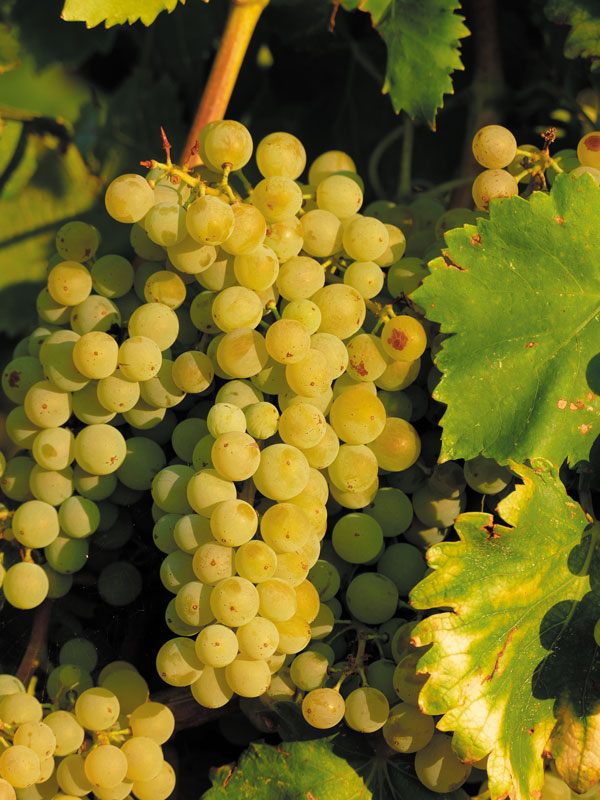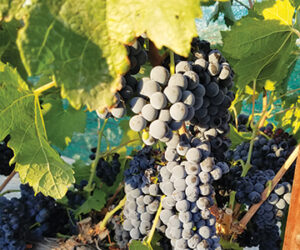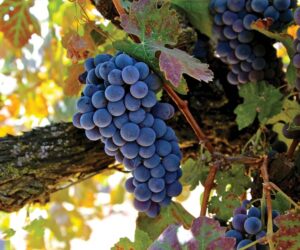Throughout my career at UC-Davis I had the opportunity to make wine from over fifty different varietals. There was a block in the campus vineyard that we referred to as the “Varieties of the World” section. There were fourteen vines per variety, which was just enough to produce one to two carboys of wine that we could use in the teaching program. I nailed some of the varieties right off the bat: Vermentino, Torrontes, and other Muscat-related varieties are a few. Others took some time to perfect. Several Rhône varieties in particular like Marsanne, Roussanne, and Grenache Blanc, all should have done well in the area — but there was something missing. The wines were flat, flabby, and lacking varietal character. This was a good example of winemaking not being just a “plug and play” situation, but rather one that needed more research. The variety that I really struggled with was Grenache Blanc, or GK as we wrote into our blend code for it. As I learned more about Grenache Blanc, I developed an appreciation for how wines are best made in the vineyard. I went back to pictures I had taken the first few years, and those photos told a thousand words. We were not farming the variety correctly for that specific site, and when we changed our farming practices, the fruit and subsequently, the wines improved. They improved so much, that when we planted a new vineyard closer to the new wine institute we selected Grenache Blanc as one of the main production grapes to use for classes.
As the name implies, Grenache Blanc is a white grape. It is prone to oxidation but has the capability to be made into full-bodied wines. It is actually a mutation of Garnacha Tinta, or Grenache Noir, which I have previously covered in this column. You can find more information about this variety, and others by visiting the Vitis International Database (https://www.vivc.de/index.php?r=site%2Findex). You should also note another mutation of Garnacha Tinta, and that is Garnacha Roja, also known as Grenache Gris depending on the region where it’s grown.

While I have previously referred to Grenache Blanc in the company of the Rhône varieties, the actual country of origin is to the southwest across the Pyrenees in Spain, where it is known as Garnacha Blanca. It is produced in the northeast Spanish provinces of Catalonia and Aragon as a varietal. It is a Denominación de Origen (DO) permitted principle variety in Alella, Costers del Segre, Tarragona, Terra Alta, Priorat, and the more well-known Rioja, but its vineyard area in Rioja is the least planted of the authorized white varieties, so really, a minor component overall in the final blends.
Back in France, it is a component in the white wines of the southern Rhône, with the largest area in Roussillon. Across the south of France, it is the ninth most planted white grape, just edging out Viognier. Croatia and the Republic of North Macedonia grow it under the name Belan, and it is generally planted in warmer vineyard sites due to its sensitivity to cold temperatures. You won’t find much Grenache Blanc planted in the United States. California has the most reportable acreage at a total of 298 acres in 2019. A majority of it is grown in California’s District 8, which is primarily the Central Coast region, where it first was introduced sometime in the very early 1990s at Tablas Creek vineyards. District 13, in the southern San Joaquin Valley, has the next highest reportable vineyard area. A smattering of Grenache Blanc is found in Oregon, Washington State, Arizona, and Colorado. There is a small subset of my brain cells that recall we came across some in Michigan at the 2019 WineMaker Conference in Traverse City.
As I learned more about Grenache Blanc, I developed an appreciation for how wines are best made in the vineyard.
The wines of Grenache Blanc vary, as with most Old-World varieties. Jancis Robinson reports that when vineyard yields are balanced, it gives the opportunity to produce a full-bodied, substantial white wine. Combine it with some percentage of oak barrels, and the wines can show very well. Of course you, as the winemaker, are the final determination as to what your final blend percentages should be. As a general rule, for white wines I will only dabble in a small percentage of oak flavors. The propensity for Grenache Blanc to oxidize steers me away from prolonged aging. But this was specific to the fruit I was getting from the UC-Davis vineyards, which in the early years there, was not yielding high-quality fruit. In the south of France, you will find most Grenache Blanc blended with other varieties such as Roussanne, Grenache Gris, and Clairette, depending on the individual AOC rules where it is being made.
Grenache Blanc is a significant component in various vin doux naturels (VDN) of southern France. The primary blends for these fortified wines are Grenache Blanc, Grenache Gris, Macabeo, and Torbato. Macabeo is relatively well known in southern France and the Rioja region of Spain. Torbato meanwhile has been relatively unknown, except on the island of Sardinia and, to a very small extent, in the south of France, where recent DNA profiling found it to be identical to Malvoisie du Roussillon, where it is described as recovering from near extinction.
Vin doux naturels wines are in this case Grenache Blanc blended with the aforementioned varieties. To make vin doux naturels you need relatively high sugars and this happens to be very easy in the south of France due to the heat and the mistral winds. The grapes are harvested, fermentation is initiated, and when the desired sweetness is achieved, the winemaker will make a grape spirits addition. Most research I have found indicates that the best techniques in arresting the fermentation is achieved by adding 95% ethanol as neutral grape spirits. On a home winemaking scale, this product can be difficult to obtain, but I recently Googled “food-grade ethanol” and was quite surprised on what I found. It certainly was not cheap, but it is possible. For less than 95% ethanol, try to arrest the fermentation, with a combination of spirits and low temperatures. The VDN styles are made in both unoxidized and oxidized styles. The former would include some small percentage of sulfur dioxide as an antioxidant, not focusing on the molecular fraction as much.
Circling back to the wines we affectionately referred to as GK in their blend numbers, you have to ask the question, what happened there? Certainly, that appreciation for how the wines were better when we understood our vineyard practices better. Given that the soil and rootstock we used were likely to create an over-cropping situation, we started thinning the crop at veraison, more specifically, one to two clusters per shoot. These were trained on a traditional bilateral-cordon system. The rows were oriented north-south and we opened up the fruiting zone on the east side to allow indirect sunlight into the canopy. These two practices combined with careful water regulation did wonders to improve the fruit we would be receiving in the winery. Once in the winery, we embarked on destemming the clusters only and pressing only the berries. A soft press was employed to express the juice, enough sulfur dioxide was added to prevent browning, then natural settling of the solids, next a racking, then checking and supplementing the acidity, and finally the yeast. After years, I think I finally got this variety to truly express itself. I used Lalvin CY3079, which can leave a small hint of sweetness in the finish. I did not initiate a malolactic fermentation and, by the time I retired, I finally got it down!
There should be a moral to every story. In this case, it was: Sometimes these things are just not as easy as they seem! This column has mentioned many times that some varieties can be a challenge, and they, that being the grapes, do not always read the winemaking textbooks we learn from. Grenache Blanc was one of those varieties for me. In any given season, it was a small percentage of the total number of varietal wines I made, and so I could not apply the techniques for say Chardonnay to Grenache Blanc. Over the years as I honed in on the varietal wines I came to appreciate the true value of blending and understanding that it has been hundreds of years of winemaking in this variety’s home regions that dictated the style for which that grape was best known. Going back to the grape’s roots helped me gain better insight in producing not only Grenache Blanc-based wines, but many of the misunderstood varietals.
Grenache Blanc Recipe
Yield 5 gallons (19 L)
Ingredients
100 lbs. (45 kg) Grenache Blanc fruit or 6 gallons (19 L) commercially available juice, clarified
Distilled water
10% potassium metabisulfite (KMBS) solution (Weigh 10 grams of KMBS, dissolve into about 75 mL of distilled water. When completely dissolved, top up cylinder up to 100 mL total with distilled water.)
5 g Lalvin CY3079 yeast (Lalvin QA23 can be used as a substitute)
5 g Fermaid K (or equivalent yeast nutrient)
5 g Diammonium phosphate (DAP)
Tartaric acid
Other equipment or needs specific to this recipe
5-gallon (19-L) carboy
6-gallon (23-L) carboy
6-gallon (23-L) plastic bucket
Airlock/stopper
Racking hoses
Grape press with a central bladder (if starting with grapes)
Equipment cleaning and sanitizing agents (Bio-Clean, Bio-San, or similar products)
Inert gas (nitrogen, argon, or carbon dioxide)
Refrigerator (~45 °F/7 °C) to cold settle the juice. (Remove the shelves so that the bucket will fit.)
Ability to maintain a fermentation temperature of 55 °F (13 °C) TIP: Use a 33-gallon (125-L) plastic can as a water bath. Place ice blocks in the water to maintain a relatively constant temperature. This will be your refrigeration system for peak fermentation. If you have other means to keep things cool, of course use that. TIP: If you have a need to keep the fermentation warm, wrapping the bucket/carboy with an electric carboy wrap (available at most home winemaking outlets) works well.
Thermometer capable of measuring between 40–110 °F (4–43 °C) in one degree increments
Pipettes with the ability to add in increments of 1 mL
Ability to test or have testing performed for sulfur dioxide, titratable acidity, and Brix
Step by Step
- Destem and press the grapes. Move the berries directly to the press and press lightly to avoid extended contact with the skins and seeds. (Vertical basket presses may require crushing the fruit.)
- Transfer the juice to a 6-gallon (23-L) bucket. During the transfer, add 16 mL of 10% KMBS solution — this addition is the equivalent of 40 mg/L (ppm) SO2. Move the juice to the refrigerator set at 55 °F (13 °C).
- Let the juice settle at least overnight. Layer the headspace with inert gas to protect the juice from oxygen and keep covered.
- Measure the Brix and titratable acidity of the grape juice.
- Adjust the acidity to 6–7 g/L using tartaric acid.
- When sufficiently settled, rack the juice off of the solids into the 6-gallon (23-L) carboy.
- Prepare yeast. Heat about 50 mL distilled water to 108 °F (42 °C). Measure the temperature. Pitch the yeast when the suspension is 104 °F (40 °C). Sprinkle the yeast on the surface and gently mix so that no clumps exist. Let sit for 15 minutes undisturbed. Measure the temperature of the yeast suspension. Measure the temperature of the juice. You do not want to add the yeast to your cool juice if the temperature of the yeast and the must temperature difference exceeds 15 °F (8 °C). To avoid temperature shock, acclimate your yeast by taking about 10 mL of the juice and adding it to the yeast suspension. Wait 15 minutes and measure the temperature again. Do this until you are within the specified temperature range. You may need to place solution in the fridge to help cool it. Do not let the yeast sit in the original water suspension for longer than 20 minutes. When the yeast is ready, add it to the fermenter.
- Add Fermaid K or equivalent yeast nutrient.
- Initiate the fermentation at room temperature ~(65–68 °F/18–20 °C) and once fermentation is noticed, (~24 hours) move to a location where the temperature can be maintained at 55 °F (13 °C).
- Two days after fermentation starts, dissolve the DAP in as little distilled water required to completely go into solution (usually ~20 mL). Add directly to the carboy.
- Normally you would monitor the progress of the fermentation by measuring Brix. One of the biggest problems with making white wine at home is maintaining a clean fermentation. Entering the carboy to measure the sugar is a prime way to infect the fermentation with undesirable microbes. So at this point, the presence of noticeable fermentation is good enough. If your airlock becomes dirty by foaming over, remove it, clean it, and replace as quickly and cleanly as possible. Sanitize anything that will come in contact with the juice.
- Leave alone until bubbles in the airlock are about one bubble per minute. Usually about two to three weeks.
- The wine is considered dry, or nearly dry when the Brix reaches -1.5 °B or less. Taste the wine, if it is dry, add 3 mL of fresh KMBS (10%) solution per gallon (3.8 L) of wine. This is the equivalent to ~40 ppm addition. Transfer the wine to the 5-gallon (19-L) carboy to eliminate headspace, then lower the temperature to 38–40 °F (3–4 °C).
- After two weeks, test for pH and SO2 adjust as necessary to attain 0.8 ppm molecular SO2. (There is a simple SO2 calculator at www.winemakermag.com/guide/sulfite). Check the SO2 in another two weeks, prior to the next racking and adjust while transferring. HINT: Rack to another sanitized 5-gallon (19-L) carboy or into your bucket. In the case of the latter, clean the original carboy and transfer the wine back to it. This is done at about 4–6 weeks after the first SO2 addition. Once the free SO2 is adjusted, maintain at the target level by monitoring every 3–4 weeks.
- Consult Winemakermag.com for tips on fining and filtration.
- At about three months you are ready to bottle. Be sure to maintain sanitary conditions while bottling. Once bottled, you’ll need to periodically check your work by opening a bottle to enjoy with friends.







